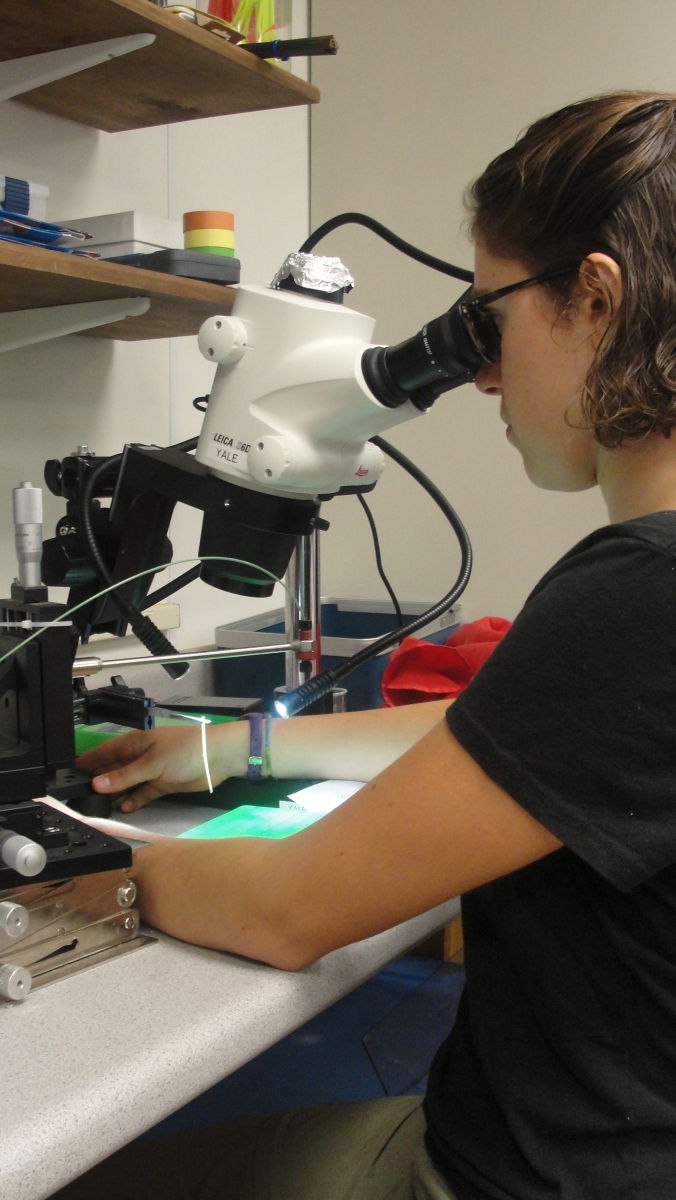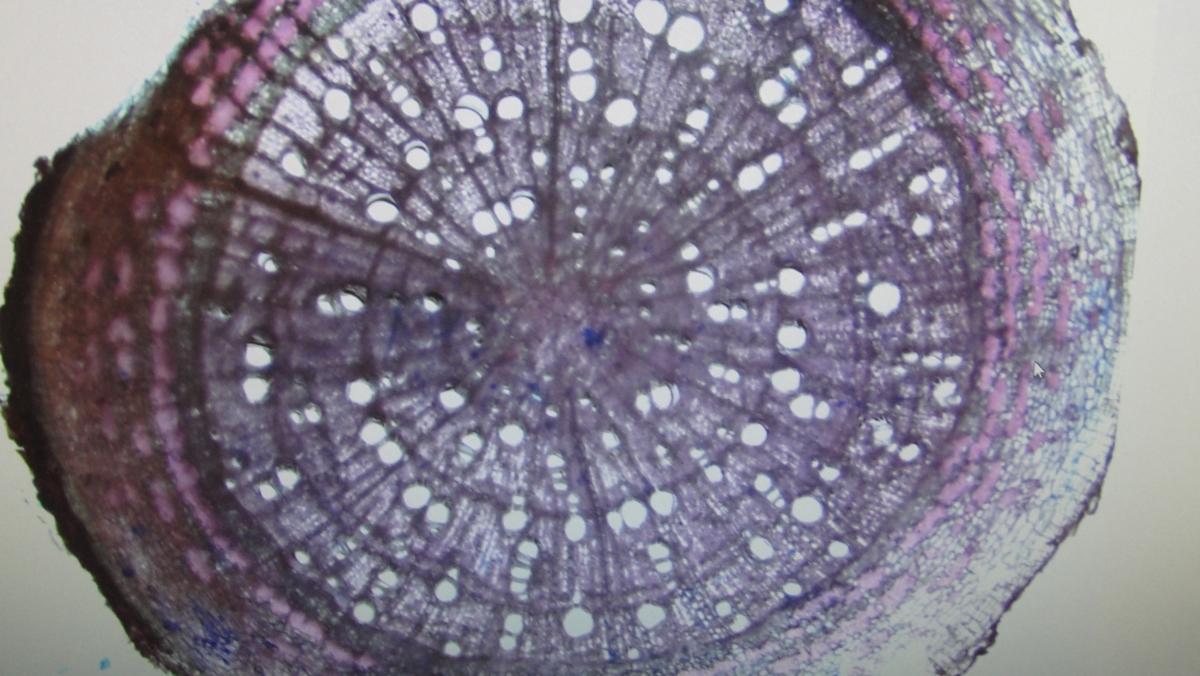You are here
Blowing Bubbles for the Sake of Science
Preview Haiku: (You will understand it by the end of my blog post!)
Air-Seeding Threshold:
pressure bomb, micropipette…
darn. Open vessel.
You may see a trend in our 2016 blog post introductions: most students at the Harvard Forest this summer are studying the impact of climate change on the New England forest system. But as you have likely also noticed, our projects diverge from there in a multitude of ways. Some budding scientists collect jars of soil or tree cores. Others work inside with computers, people, or even paint. Regardless of material, we manage to use science, communication and art to come to meaningful conclusions and to grow as leaders.
So, you may ask, what is my medium? I have dabbled in the world of hard tools: trowels, shovels, and even a machete and a bucket lift (fondly called "Bucky") have come in handy. I work with leaf and trunk tissue samples every day in both lab and field. But the object that best describes and defines my summer's work is, in fact, a tiny stream of air bubbles. In the world of plant hydraulics, bubbles enable scientists to quantify how different ages and species of trees react to drought. Droughts are predicted to become more frequent and more severe with climate change. As a result, these bubble-derived measurements are increasingly relevant, and can help us project how the New England forest may adapt over time.
Like humans, trees rely on very thin tubing to channel and distribute fluids. In humans, these tubes are called arteries or veins; in trees, the hydraulic system is founded upon xylem. Xylem pumps water from the roots to the shoots to aid in photosynthesis and maintain the structural integrity of individual cells.
Humans rely upon their hearts to circulate blood. Trees are loving, but heartless; how do they do it? It turns out that the surrounding atmosphere powers flow singlehandedly. As water evaporates into the air from the underside of a leaf, water further down in the tree's xylem is pulled up via cohesion (e.g. "stickiness" to other water molecules) and tension (the act of being stretched tight). Xylem is in many ways like a very long, VERY thin straw.
There is one main factor that distinguishes xylem from a straw, though. While water is constantly traveling through the tree, it experiences many points of resistance along the way. This is due to the fact that xylem is not a continuous tube. Xylem is rather a network of tube-like elements connected by semi-porous membranes, through which the water column must pass. At first glance, it may seem as though these membranes are more trouble than they're worth: water transport would be faster and less pressure-intensive if they didn't exist. But when events such as drought come along, such barriers become critical to a tree's survival.
When a tree is healthy, the xylem network has all water and no bubbles. But factors such as groundwater scarcity and abnormally hot and/or dry weather add some kinks along the line. If a column of water is stretched too far, it will break and form…you guessed it. An air bubble. Air bubbles disrupt flow. Luckily, though, air bubbles are generally contained within a single xylem element. The element's membranes (I told you they'd come in handy!) prevent the air from spreading, and the surrounding xylem network can go about its normal business. Only when a drought is particularly long and/or severe will the air bubbles, known as "embolisms," be able to travel across membranes and wreak havoc upon the entire vascular system. Widespread embolism can quickly result in tree damage or even death.
 My team's research revolves around this breaking point: the dryness level at which a tree can no longer control the spread of its embolisms. Every week, we collect samples of Red Oak, Red Maple, American Beech, and White Ash trees. The first half of the summer, we focused on saplings, but our next three weeks will be largely devoted to mature trees. My colleagues and I test the hydraulic strength and resistance of the trees in a variety of ways. However, fellow undergraduate Nathan Stephansky and I mostly use microscopes, micropipettes and micromanipulators (it's small, I know) to find the drought resistance of different tissue types. Our particular method, air-seeding, is a way to simulate embolism in a lab. Nathan and I start by looking at tissue samples (stem segments, leaves, root samples, etc.) under a microscope. Once we find a xylem vessel, we insert a tiny, glass pipette into it. This micropipette is rigged to a pressure chamber, which channels nitrogen gas through the pipette into the xylem vessel at a fixed rate.
My team's research revolves around this breaking point: the dryness level at which a tree can no longer control the spread of its embolisms. Every week, we collect samples of Red Oak, Red Maple, American Beech, and White Ash trees. The first half of the summer, we focused on saplings, but our next three weeks will be largely devoted to mature trees. My colleagues and I test the hydraulic strength and resistance of the trees in a variety of ways. However, fellow undergraduate Nathan Stephansky and I mostly use microscopes, micropipettes and micromanipulators (it's small, I know) to find the drought resistance of different tissue types. Our particular method, air-seeding, is a way to simulate embolism in a lab. Nathan and I start by looking at tissue samples (stem segments, leaves, root samples, etc.) under a microscope. Once we find a xylem vessel, we insert a tiny, glass pipette into it. This micropipette is rigged to a pressure chamber, which channels nitrogen gas through the pipette into the xylem vessel at a fixed rate.
How do we test the xylem's pressure limits? That is where the stream of air bubbles comes in. The bottom half of our tissue sample is submerged in water. If we inject air and air bubbles immediately stream out the bottom of the sample, we know the vessel in question doesn't have a membrane in that particular segment, which we call being "open." We test vessels until we find a "closed" specimen, or one that has one or more membranes within the segment. At that point, we super glue the micropipette into place, turn the pressure chamber back on, put on safety goggles, and wait. As soon as the xylem membrane ruptures--the synthesized embolism has "spread"--bubbles will appear, and we can take and record our pressure measurement.
 Air injection work can be frustrating and tedious. Red Oak samples are rife with open vessels, sometimes preventing us from obtaining an actual measurement; Red Maple vessels are very small and hard to see under the microscope; and sometimes the stream of bubbles for which you are waiting never comes or appears in the form of an unwanted leak. But bubble by bubble, we are finding patterns. Some tissue types "bubble up" at lower pressures than others, suggesting they would fare worse in extreme drought conditions. There is difference in drought resistance between tree species and tree age as well. Much of our data analysis will occur after the summer is over--my mentors' National Science Foundation grant is for three years. Nonetheless, a simple glance at our data sheets is reminder enough of our project's significance. Our measurements will allow us to predict the future tree composition of a climate change-affected, New England forest. The fact that our predictions will be put to the test in my lifetime is both terrifying and motivating. For those reasons, I look forward to the remaining bubbles this summer will bear.
Air injection work can be frustrating and tedious. Red Oak samples are rife with open vessels, sometimes preventing us from obtaining an actual measurement; Red Maple vessels are very small and hard to see under the microscope; and sometimes the stream of bubbles for which you are waiting never comes or appears in the form of an unwanted leak. But bubble by bubble, we are finding patterns. Some tissue types "bubble up" at lower pressures than others, suggesting they would fare worse in extreme drought conditions. There is difference in drought resistance between tree species and tree age as well. Much of our data analysis will occur after the summer is over--my mentors' National Science Foundation grant is for three years. Nonetheless, a simple glance at our data sheets is reminder enough of our project's significance. Our measurements will allow us to predict the future tree composition of a climate change-affected, New England forest. The fact that our predictions will be put to the test in my lifetime is both terrifying and motivating. For those reasons, I look forward to the remaining bubbles this summer will bear.
Concluding Haiku:
Microscope, sore eyes
A day's work can be draining.
Yet, the future is bright.


